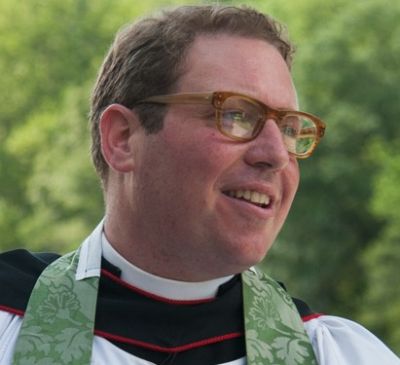Sermons from St. John's Episcopal Church
Apr 07, 2023 |
Good Friday Sermon - Stay by the Cross
|
Good Friday Sermon - Stay by the Cross
Deep down, Good Friday has always made me feel somewhat uncomfortable. I share this because I think I may not be alone in this experience. The relatively light attendance today, despite it being a day many have off from work, and schools are often closed, is a testament to this.
The culture I grew up in didn’t like to spend too much time dwelling on bad news. We were often invited to chin up, or move on after some sort of bad experience. And, truthfully, I didn’t have many major tragedies in my life. I had grandparents die. I had pets die. I had friends move away. And our family moved when I was 13. But I was shielded from most really bad news as a child.
Loss and death were something I barely understood. And the few times I saw my parents going through something hard they seemed to exist at extremes. My father was always stoic and calm, as is the expectation of fathers. My mother tried to keep calm as well, but sometimes she would be overcome and get lost in her feelings - only to express guilt later.
I wonder if this pattern is familiar to any of you? It seems to be consistent with our culture’s expectations of us. Bad feelings are kept below the surface until they force their way out? And then when they are expressed it happens quickly, without ceremony, perhaps even wildly. And thus sadness and grief begin to appear dangerous.
And so, Good Friday’s direct engagement with the pain of Jesus’s final hours and ultimate death, runs counter to our well-rehearsed expectations. It doesn’t adhere to our standards of stoic public behavior. And it also doesn’t resemble the outbursts of pain that break their way through our attempts at control. No, what’s happening today is something different.
—
Today we look directly into the face of Jesus on the Cross.
—
It’s rare in church that we spend more time with the death of Jesus than we do with his Resurrection. But today we pause, and we remember what happened.
What happened, the role of the people in bringing it about, and how something like that could happen again today. How possibly things like this DO happen today.
Good Friday packs it all together and invites us to dwell in the moment - to experience the full impact of sin in the world, sin in our own lives, and the deep love of God to join us on this Earth, to experience the impact of our brokenness, and to die to save us.
All over, Christians are gathering to remember this moment in ways that have been used going back at least as far as the 4th Century, when a woman named Egeria traveled to Rome. She tells how in the 380s, Good Friday was remembered by reading the same passages from John that we just heard. We repeat the same story, remembering. In some churches (yes, even Epsicopal churches!) Christians bring their bodies into play, venerating a wooden cross, just as pilgrims in the 4th century paid their respect to fragments of the cross on which Jesus died.
These ancient practices invite us to dwell with the pain.
The pain of Jesus’s death.
The pain of losing loved ones.
The pain of every human death.
The pain of each person who dies unnecessarily.
The pain of our own sin and how we hurt one another.
The pain of our own callousness and resistance to change.
We look directly into the face of the forces of sin and death that hurt us and the whole world. And we recognize that they are powerful. Powerful enemies, powerful instigators, powerful temptations. It forces us to look not only at the powers of evil in the world, but also within ourselves.
On Good Friday we grieve not only the death of Christ, but also the parts of ourselves that seem to be dead, or bring death to others. It’s not an easy place to be. Today we recognize the knowledge of evil that the first humans claimed in the garden at the beginning of time - and the tremendous gift that God sent in the form of Jesus, to bear the consequences of that evil.
In a normal sermon, this is where I’d begin to turn the corner. To shift our attention from the pain of the cross to the miracle of the resurrection. That’s the job of the preacher, after all, to break open the Good News to the people. But today I’m not going to do that. I invite you to come back on Easter morning to hear the end of the story.
Today, instead, I’m going to try to remain here, in this uneasy place. To remain with the altar that has been stripped clean of all its fine linens and candles. To remain dressed only in the plain black cassock. To remain with the experience of our own pain and the knowledge of our impact on each other and the world.
Five hundred years ago, the Spanish Catholic priest Ignatius of Loyola made this moment the heart of his spiritual direction, inviting the seeker to dwell with Christ in his passion. Here is what he said:
To remain with Jesus as he remains with us.
Because without this moment, there is no Easter Morning. Without the Cross there is no empty tomb. Without Death there is no Resurrection.
So we wait. We dwell. We remain. In trust that God has not abandoned us, just as we have not abandoned God.
The culture I grew up in didn’t like to spend too much time dwelling on bad news. We were often invited to chin up, or move on after some sort of bad experience. And, truthfully, I didn’t have many major tragedies in my life. I had grandparents die. I had pets die. I had friends move away. And our family moved when I was 13. But I was shielded from most really bad news as a child.
Loss and death were something I barely understood. And the few times I saw my parents going through something hard they seemed to exist at extremes. My father was always stoic and calm, as is the expectation of fathers. My mother tried to keep calm as well, but sometimes she would be overcome and get lost in her feelings - only to express guilt later.
I wonder if this pattern is familiar to any of you? It seems to be consistent with our culture’s expectations of us. Bad feelings are kept below the surface until they force their way out? And then when they are expressed it happens quickly, without ceremony, perhaps even wildly. And thus sadness and grief begin to appear dangerous.
And so, Good Friday’s direct engagement with the pain of Jesus’s final hours and ultimate death, runs counter to our well-rehearsed expectations. It doesn’t adhere to our standards of stoic public behavior. And it also doesn’t resemble the outbursts of pain that break their way through our attempts at control. No, what’s happening today is something different.
—
Today we look directly into the face of Jesus on the Cross.
—
It’s rare in church that we spend more time with the death of Jesus than we do with his Resurrection. But today we pause, and we remember what happened.
What happened, the role of the people in bringing it about, and how something like that could happen again today. How possibly things like this DO happen today.
Good Friday packs it all together and invites us to dwell in the moment - to experience the full impact of sin in the world, sin in our own lives, and the deep love of God to join us on this Earth, to experience the impact of our brokenness, and to die to save us.
All over, Christians are gathering to remember this moment in ways that have been used going back at least as far as the 4th Century, when a woman named Egeria traveled to Rome. She tells how in the 380s, Good Friday was remembered by reading the same passages from John that we just heard. We repeat the same story, remembering. In some churches (yes, even Epsicopal churches!) Christians bring their bodies into play, venerating a wooden cross, just as pilgrims in the 4th century paid their respect to fragments of the cross on which Jesus died.
These ancient practices invite us to dwell with the pain.
The pain of Jesus’s death.
The pain of losing loved ones.
The pain of every human death.
The pain of each person who dies unnecessarily.
The pain of our own sin and how we hurt one another.
The pain of our own callousness and resistance to change.
We look directly into the face of the forces of sin and death that hurt us and the whole world. And we recognize that they are powerful. Powerful enemies, powerful instigators, powerful temptations. It forces us to look not only at the powers of evil in the world, but also within ourselves.
On Good Friday we grieve not only the death of Christ, but also the parts of ourselves that seem to be dead, or bring death to others. It’s not an easy place to be. Today we recognize the knowledge of evil that the first humans claimed in the garden at the beginning of time - and the tremendous gift that God sent in the form of Jesus, to bear the consequences of that evil.
In a normal sermon, this is where I’d begin to turn the corner. To shift our attention from the pain of the cross to the miracle of the resurrection. That’s the job of the preacher, after all, to break open the Good News to the people. But today I’m not going to do that. I invite you to come back on Easter morning to hear the end of the story.
Today, instead, I’m going to try to remain here, in this uneasy place. To remain with the altar that has been stripped clean of all its fine linens and candles. To remain dressed only in the plain black cassock. To remain with the experience of our own pain and the knowledge of our impact on each other and the world.
Five hundred years ago, the Spanish Catholic priest Ignatius of Loyola made this moment the heart of his spiritual direction, inviting the seeker to dwell with Christ in his passion. Here is what he said:
I ask for what I desire. Here is it what is proper for the Passion: sorrow with Christ in sorrow;
a broken spirit with Christ so broken; tears; and interior suffering because of
the great suffering which Christ endured for me.
Ignatius encouraged his directees to allow the Holy Spirit to bring them into this very moment. To experience the sights and sounds even smells of the Passion. Because through that we might be able to feel just for a moment what he feels for us. a broken spirit with Christ so broken; tears; and interior suffering because of
the great suffering which Christ endured for me.
To remain with Jesus as he remains with us.
Because without this moment, there is no Easter Morning. Without the Cross there is no empty tomb. Without Death there is no Resurrection.
So we wait. We dwell. We remain. In trust that God has not abandoned us, just as we have not abandoned God.
Jan 29, 2023 |
Doing research is doing justice
| The Rev. Dr. Craig Townsend
Doing research is doing justice
Dr. Townsend is the Associate for Faith Formation at St. Ann & the Holy Trinity Episcopal Church in Brooklyn Heights. He serves as the Historian in Residence for Racial Justice for the Episcopal Diocese of Long Island. Craig is spearheading the Uncovering Parish Histories Project which helps parishes explore churches research their histories of involvement in slavery and the slave economy in antebellum America, of involvement in anti-slavery movements, and of later manifestations of both racial discrimination and injustice and racial reconciliation and justice. St. John’s has been participating in this project for over a year.
Craig received his Ph.D. in the Study of Religion from Harvard University; in American Religious History. His research for that degree led to a book entitled Faith in Their Own Color: Black Episcopalians in Antebellum New York City (Columbia University Press, 2005).
Craig received his Ph.D. in the Study of Religion from Harvard University; in American Religious History. His research for that degree led to a book entitled Faith in Their Own Color: Black Episcopalians in Antebellum New York City (Columbia University Press, 2005).
